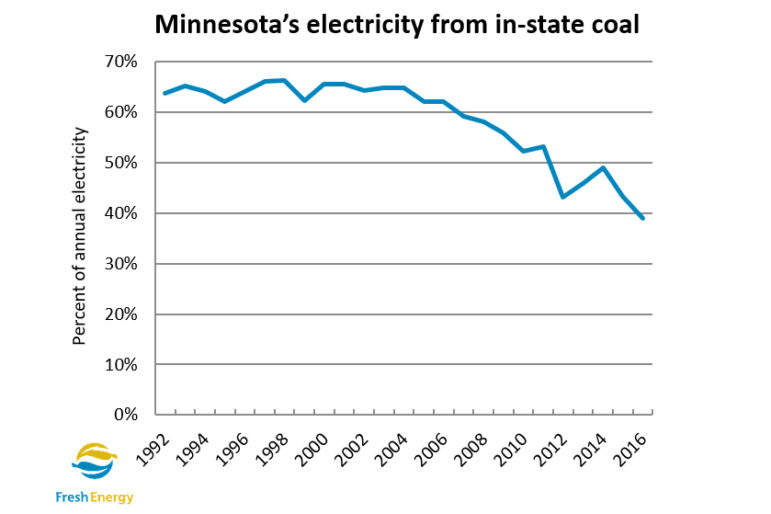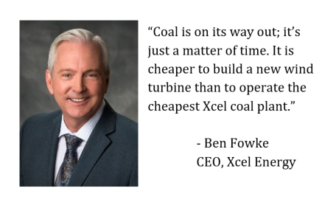
Then: Minnesota has been historically dependent on coal, despite having no coal deposits in the state. When Fresh Energy was founded in 1992, Minnesota generated almost two-thirds (64 percent) of its electricity from coal and utilities were still proposing new coal plants here and across the country.
Now: Thanks to the advocacy of Fresh Energy, Minnesota has gone from proposing new coal plants to securing the retirement of 19 of the 23 large coal-burning units in Minnesota. Between 1992 and 2016, Minnesota has significantly cut back on its use of coal from 64 percent to 39 percent of Minnesota’s electricity generation. Historic low costs for wind and solar generation and large advances in energy efficiency deployment have put pressure on utilities to retire their coal plants early. Yet because burning coal results in massive amounts of carbon and fine particulate pollution, coal plants are Minnesota’s biggest source of global warming pollution, and their emissions harm human health.

Next: Fresh Energy will continue to advocate for the retirement and efficient, renewable replacements of Minnesota’s remaining four coal-burning power plants. We will ensure that state regulators use the updated real health and environmental costs of carbon and other pollutants from power plants and will demonstrate that combinations of energy efficiency, demand response, energy storage, solar, and wind investments are better alternatives. The move away from large power plants to more distributed energy resources won’t just make the grid cleaner and more cost effective, but also more resilient. There’s no better model for this kind of dramatic carbon reduction than Minnesota-based Xcel Energy. In just a few short years they’ve shifted their strategic plan and committed to an 85 percent carbon-free energy mix by 2030. Ben Fowke, the CEO of Xcel Energy, said it best: “Coal is on its way out; it’s just a matter of time. It is cheaper to build a new wind turbine than to operate the cheapest Xcel coal plant.”
Fresh Energy has shaped and led Minnesota progress on reducing carbon emissions and retiring coal plants:
1993: Fresh Energy’s first legislative advocacy resulted in the passage of a state law that required regulators to consider the health and environmental externalities when weighing utility proposals to invest more in fossil-fuel power plants.
1994: The Minnesota legislature set into law a preference for prioritizing energy efficiency, then renewable energy, then natural gas, and then coal and nuclear, for supplying new power needs.
2001: The Minnesota legislature approved a deal Fresh Energy helped work out with Xcel Energy to stop burning coal at two inner-city power plants and add air pollution controls to a third metro-area coal plant.
2006: The Minnesota Legislature passed into law a policy on which Fresh Energy worked with utilities, the state, and the Minnesota Chamber of Commerce, to require 90 percent mercury emissions reductions from the state’s six largest coal-burning power plants.
2007: Minnesota passed the Next Generation Energy Act setting science-based economywide state greenhouse gas reduction goals.
- “It is the goal of the state to reduce statewide greenhouse gas emissions across all sectors producing those emissions to a level at least 15 percent below 2005 levels by 2015, to a level at least 30 percent below 2005 levels by 2025, and to a level at least 80 percent below 2005 levels by 2050.”
2009: Fresh Energy’s successfully advocated that a new coal proposal proposed to be built in South Dakota was not needed to serve Minnesota customers.
2015: Fresh Energy used the same analytical model used by utilities to prove that retiring large coal units owned by Xcel Energy and replacing them with large increments of efficiency, wind, and solar was the least-cost option for Xcel.
2016: The Public Utilities Commission approved Xcel’s revised 15-year plan, including retirement of those big coal units.
2017: The Public Utilities Commission updated the externalities values that utilities are required to include in plans when evaluating resource decisions, adopting more scientifically valid carbon dioxide health and environmental costs, as advocated by Fresh Energy.




